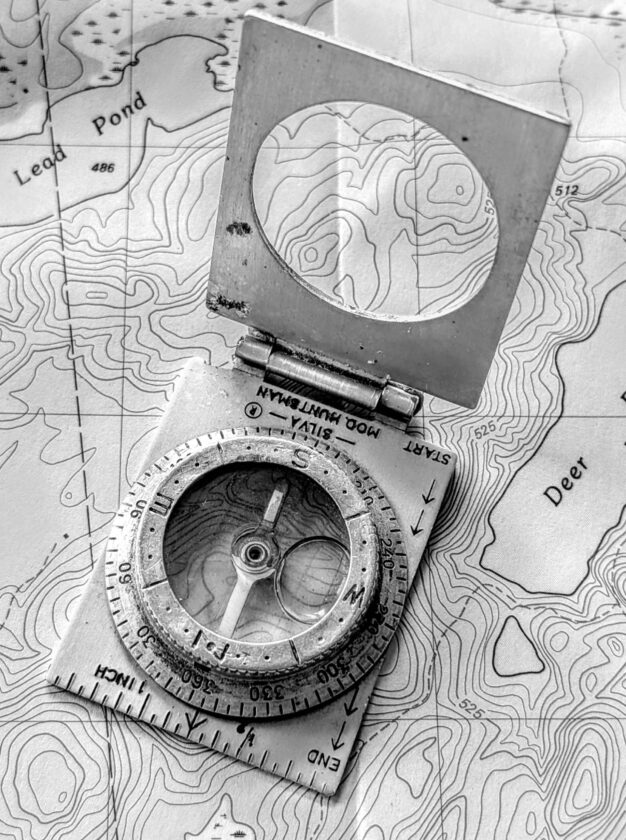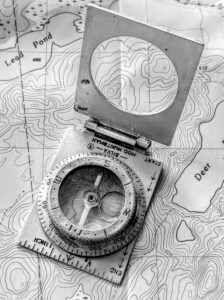Deal me in

My trusty Silva Huntsman compass. (Provided photo — Jack Drury)
I got a relatively late start to big game hunting. In 1972, I graduated from college, moved to Saranac Lake, and Tom Cantwell, family patriarch, suggested — no, more like demanded — I get my hunting license. Dutifully, I went to the Fish & Game Club, got my hunter safety certificate, sighted in my dad’s ancient Winchester Model 1894, and before I knew it, I was hunting.
I knew nothing about hunting and probably spent more time wondering where I was than knowing where I was. Plus, any deer I saw were spooked well before I got them in my sights.
What did I learn in those early years? Number one was map and compass skills. By 1970, I had self-taught myself how to read a map and use a compass and had practical experience exploring the Wind Rivers of Wyoming. Its vast open country with jagged peaks allows you to see for miles. The distinct and rugged mountains provide clear landmarks that are easily interpreted on a map, so good compass skills are rarely needed. In contrast, the Adirondacks offer a different challenge: the forest swallows the sky and every hill, tree and swamp looks alike. Novices need to constantly check their compass and frequently cling to contour lines like lifelines. I’ve always said, if you can navigate the wooded forests of the Adirondacks, you can navigate anywhere.
I would pin my Silva Huntsman compass onto my shirt and start hunting, knowing that if I headed north, I would hit a road, and if I headed south, I’d end up at a lake. If I hunted east or west, I could go days before I encountered anything. I hunted north and south.
The other things I learned in those early years were the basics of Deer Hunting 101. I started to interpret what the tracks could tell you. What direction were they traveling? Were they running or walking? Were the hoof prints deep or shallow? I observed my first deer scrapes, rubs and beds. I even saw the imprint of the deer’s antlers in the deep snow where the deer had been feeding.
In the early 1970s, deer were few and far between in the Adirondacks and I had no luck shooting one. In 1986, I got invited to hunt with my friends in the Southern Tier where I finally shot my first buck, a nice four point. In addition, my sister bought a farm in Rensselaer County where there were nearly as many deer as mosquitoes in July. An annual ritual began where I joined her there to hunt.
It wasn’t until the early 2000s that I found success in the Adirondacks. Eventually, I bought a new rifle, and in 2003 purchased a muzzleloader. A muzzleloader, like the name implies, is a firearm that’s loaded from the open end of the barrel. Imagine me channeling Davey Crockett and Ol’ Betsy. In the Adirondacks, muzzleloader season is a week long and runs prior to the regular season. It ended a week ago and provided me with a variety of memories — some for the wrong reasons.
According to experts, there may be close to three times as many deer in the Adirondacks now than when I started hunting. While I’ve learned my fair share about white tail deer, I’m still no expert, and here’s my take on hunting: It’s much more like playing poker than playing chess. To be the best at either requires great skill, but while luck plays a minimal role in chess, it plays a tremendous role in poker. Poker depends on the luck of the draw. Like poker, doing everything right doesn’t guarantee success with hunting.
I highly anticipate muzzleloader season. Its first day begins long before dawn, built on weeks — sometimes months — of anticipation and preparation. Rifles are sighted in, gear is checked and rechecked, and I study maps to refamiliarize myself with every ridge, swamp and draw.
How did it go?
I hunted hard for seven days. I saw one deer, and it was on the last day of the season. It was about 70 yards away, for just a moment. Then I strained to see it through the mixed forest but couldn’t. I waited. And I waited. I knew it had to be down there below me. But I had no idea where. Time was moving slower than cold maple syrup on a frosty morning. A mix of adrenaline and calm washed over me, my eyes straining for the slightest movement. Thoughts race between patience and strategy. Where will it reappear? Do I have a safe shot? How much longer can I hold my breath
After what seemed like forever, it came running full tilt in my direction. I tried to get the rifle up ahead of the deer as it burst through the woods. But I failed. The deer was not a deer; it was a blur. It tore through the trees and before I knew it, it was gone. All I was looking at was thick coniferous woods.
I missed my one chance. I did everything right. I made sure the wind was right. I hunted where I saw plenty of signs. I hunted areas where I’ve had previous luck.
I played the hand dealt to me as well as I could.
I was dealt a lousy hand.



